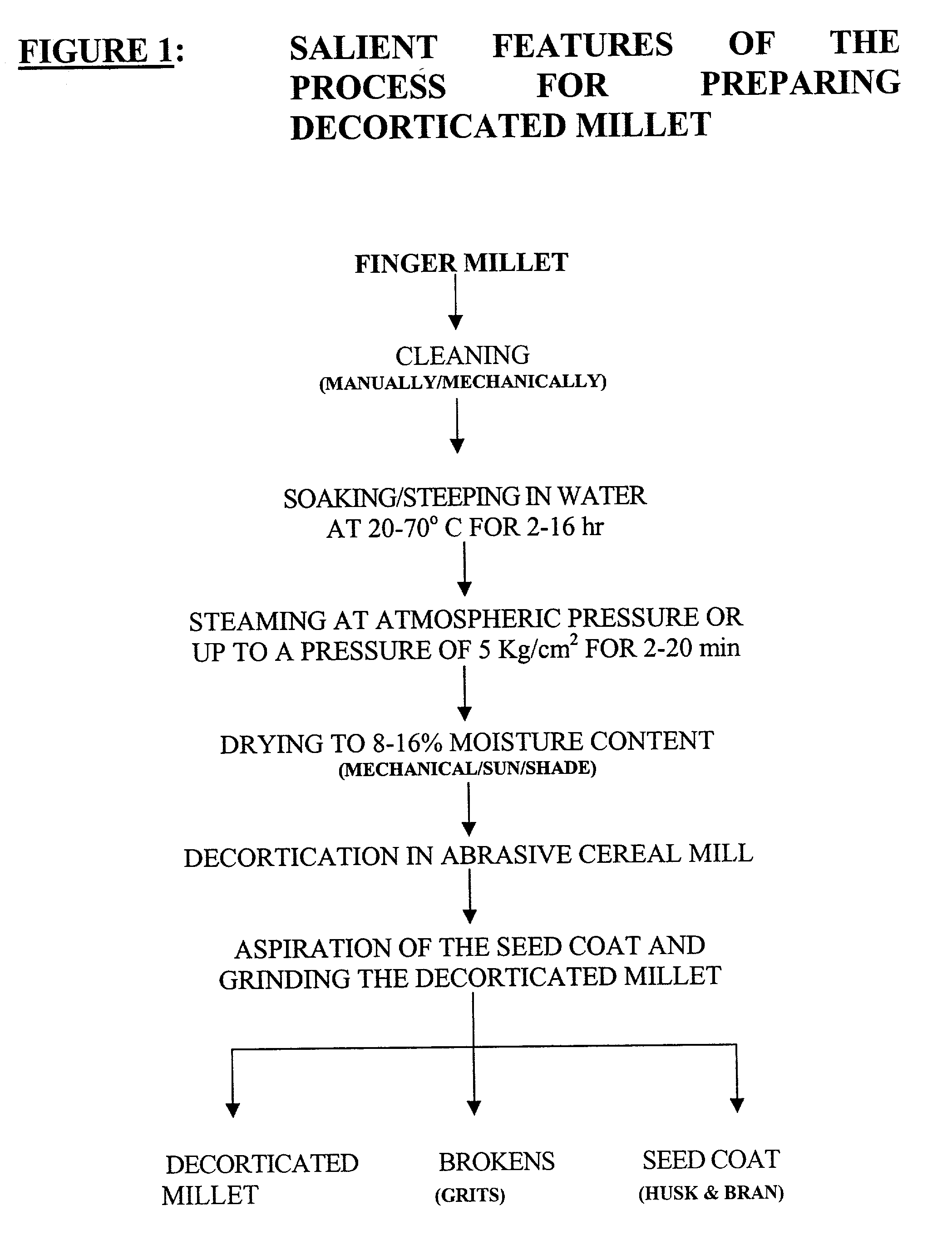Decorticated finger millet (eleusine coracana) and a process for preparing the decorticated finger millet
- Summary
- Abstract
- Description
- Claims
- Application Information
AI Technical Summary
Benefits of technology
Problems solved by technology
Method used
Image
Examples
example-- 1
EXAMPLE--1
[0054] Twenty five kilograms of the millet cleaned off the extraneous matter manually was washed with a minimum of two volumes of potable water 2 times and soaked in 40 L water at 28.degree. C. for 12 hr. The soaked material was washed again to free it from the floatings and leachates and was collected over a 25 mesh metallic screen to drain off the adsorbed water, followed by spreading in 10 Nos. of 1.5'.times.3'.times.2" dimension metallic trays. The trays were placed one above another in an autoclave, the top tray was covered with another tray and the material was steamed at atmospheric pressure for 20 min. The steamed millet was dried to 12% moisture content in a mechanical air drier maintained at 40.degree. C. A portion of the dried millet was decorticated in an emery coated horizontal plate mill, adjusted to 1.4 mm clearance between the plates and the other portion was mixed with 5.0% additional water, tempered for 10 min and decorticated in the same mill. The seed c...
example-- 2
EXAMPLE--2
[0055] Twenty five kilograms of the millet cleaned off the extraneous matter manually was washed with a minimum of two volumes of potable water 2 times and soaked in 40 L water at 28.degree. C. for 12 hr. The soaked material was washed again to free it from the floatings and leachates and was collected over a 25 mesh (BSS) metallic screen to drain off the adsorbed water, followed by spreading in 10 Nos. of 1.5'.times.3'.times.2" dimension metallic trays. The trays were placed one above another in an autoclave, the top tray was covered with another tray and the material was steamed at 5 kg / cm.sup.2 pressure for 2 min. The steamed millet was dried to 12% moisture content in a mechanical air drier maintained at 40.degree. C. A portion of the dried millet was decorticated in an emery coated horizontal plate mill, adjusted to 1.4 mm clearance between the plates and the other portion was mixed with 5.0% additional water, tempered for 10 min and decorticated in the same mill. The...
example-- 3
EXAMPLe--3
[0056] One hundred kilo grams of finger millet was cleaned using destoner and was washed with a minimum of 2 volumes of potable water 2 times and soaked in 60 L water at 28.degree. C. for 12 hr. The soaked material was washed again to free from floatings and leachates and was collected over a 25 mesh metallic screen to drain off the adsorbed water, followed by spreading in 40 Nos. of 1.5'.times.3'.times.2" dimension metallic trays. Ten trays containing the soaked millet at a time, were placed one above another in an autoclave, the top tray was covered with another tray and steamed at atmospheric pressure for 20 min. The steamed millet was dried to 12% moisture content in a mechanical air drier maintained at 40.degree. C. The product was graded by sifting through 1.4 mm and 1.0 mm opening metallic screens successively. The millet grains bigger than 1.4 mm, smaller than 1.4 and bigger than 1.0 mm, and smaller than 1.0 mm, diameter were collected separately. Thus graded mille...
PUM
 Login to View More
Login to View More Abstract
Description
Claims
Application Information
 Login to View More
Login to View More - R&D
- Intellectual Property
- Life Sciences
- Materials
- Tech Scout
- Unparalleled Data Quality
- Higher Quality Content
- 60% Fewer Hallucinations
Browse by: Latest US Patents, China's latest patents, Technical Efficacy Thesaurus, Application Domain, Technology Topic, Popular Technical Reports.
© 2025 PatSnap. All rights reserved.Legal|Privacy policy|Modern Slavery Act Transparency Statement|Sitemap|About US| Contact US: help@patsnap.com

